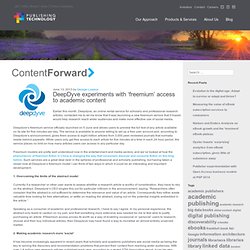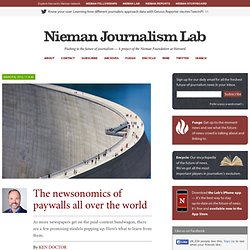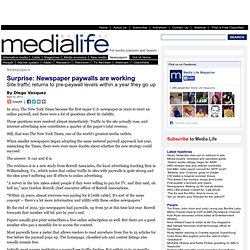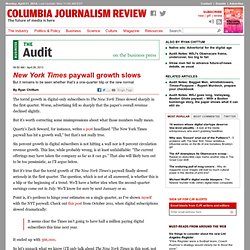

Médias: place au mur payant 2.0. DeepDyve experiments with ‘freemium’ access to academic content. Earlier this month, Deepdyve, an online rental service for scholarly and professional research articles, contacted me to let me know that it was launching a new freemium service that it hoped would help research reach wider audiences and make more effective use of social media.

Deepdyve’s freemium service officially launched on 5 June and allows users to preview the full text of any article available on its site for five minutes per day. The service is available to anyone willing to set up a free user account and, according to Deepdyve’s announcement, gives them access to eight million articles from 3,000 peer-reviewed journals that normally reside behind paywalls. While users only get free access to each article for five minutes at a time in each 24 hour period, the service places no limit on how many articles users can access in any particular day.
The newsonomics of paywalls all over the world. By the end of this year, figure that about 20 percent of the U.S.’s 1,400-plus dailies will be charging for digital access.

Gannett’s February announcement that it’s going paywall at all its 80 newspapers galvanized attention; when the third largest U.S. newspaper site, the Los Angeles Times, went paid this week, more nodding was seen in publishers’ suites. More than a dozen dailies in Europe are charging, led by Finland’s Sanoma (see “Sanoma’s Big Bundled Success”), Axel Springer, and News Corp.’s Times of London. It looks like more than a dozen in Germany alone may be charging by year’s end. Médias en ligne: il existe des modèles économiques qui marchent. Zuora CEO on doing paywall 2.0 right - video.
Zuora wants to improve paywalls with subscriber-centric approach. Zuora, a cloud-based subscription management and billing company, is attempting to revamp the idea of the online paywall with the introduction of Z-Business for Media.

Self-touted as one of the "pioneers of the 'Subscription Economy,'" Zuora boasted that this new platform will enable media outlets to meet changing demands from consumers amid mobile and social media influences. The Redwood City, Calif. -based business argued that those changes require more flexible paywalls, higher-free paid conversion rates, cross-content bundling and support for multi-device experiences. Furthermore, Zuora suggested that the biggest change that needs to come about is where the focus is when building a paywall, hinting that the current driver is the advertiser.
Der Spiegel and the paywall debate. Georg Mascolo and Mathias Muller von Blumencron took over editing Der Spiegel in 2008, with the ultimate goal of bringing the operation of the magazine’s print and online strands closer together through the collaborative efforts of the two editors.

However, disagreements saw the two splinter in 2011, with Mascolo taking responsibility for the print edition, and Blumencron the digital side. The recent firings have occurred as a result of an escalating dispute over the proposed addition of an online paywall that would restrict certain content on the site to paying viewers. Blumencron opposed the idea, with Mascolo pressing for its implementation. The pair have now been fired by the Der Spiegel’s board of directors. New York Times Paywall. Papers Worldwide Embrace Web Subscriptions. The paywalls go up – but papers still aren't secure. Are paywalls the future of magazines. How to make paywalls work for traditional magazines. The challenge of getting web users to pay for content has kept many a publisher awake at night these past few years.

Just what will people pay for online? Ryan O'Meara, watching a TV movie one night, has stumbled across the answer… Making money online with digital content is getting harder by the day if you believe the relentless tales of woe coming from corporate results in the publishing sector. As the barriers to entry come down for online publishers, the digital media space is a battleground where free content is having a major impact on profitable opportunities for traditional publishers.
There is a much discussed school of thought that says consumers expect the words and pictures that appear on a web page to be free, so charging for web content is a real challenge that many of the major publishers of the world have yet to crack. Assessing the Globe’s paywall numbers. Phillip Crawley In October, The Globe and Mail joined a growing group of newspapers putting up website paywalls; today the paper released encouraging numbers on the impact of charging readers for digital access.

Surprise: Newspaper paywalls are working. In 2011, The New York Times became the first major U.S. newspaper in years to erect an online paywall, and there were a lot of questions about its viability.

Those questions were resolved almost immediately. Traffic to the site actually rose, and internet advertising now contributes a quarter of the paper’s total revenue. Paywalls. Le coin des exposés : Thème anglais. Un nouveau site web pour Playbac Presse l'éditeur de Mon Quotidien - RevSquare. Play Bac Presse, en autre l’éditeur français de quotidiens pour enfants (Le Petit Quotidien et Mon Quotidien) et ados (L’actu) vient de lancer un premier sitecomplémentaire à son journal Mon Quotidien.

Le site adopte un business modèle freemium : une partie gratuite, une partie payante. La stratégie éditoriale est de proposer un contenu supplémentaire au journal papier. Mais, également, de proposer les archives des excellentes infographies développées par le journal. Déjà un millier d’entre elles sont accessibles sur le site. RevSquare / Mignon-Media a accompagné l’équipe de Play Bac de la stratégie au développement produit. C’est toujours sur Axure que les designs ont été intégrés afin de réaliser des tests utilisateurs. Un des challenges a été de faire communiquer différentes plate-formes d’abonnement. RevSquare a aussi travaillé sur la refonte de la boutique Play Bac Presse. New York Times paywall growth slows. The torrid growth in digital-only subscribers to The New York Times slowed sharply in the first quarter.

Worse, advertising fell so sharply that the paper’s overall revenue declined slightly. But it’s worth correcting some misimpressions about what those numbers really mean. Quartz’s Zach Seward, for instance, writes a post headlined “The New York Times paywall has hit a growth wall,” but that’s not really true. Six percent growth in digital subscribers is not hitting a wall nor is 8 percent circulation revenue growth. This line, while probably wrong, is at least unfalsifiable: “The current offerings may have taken the company as far as it can go.” Malgré ses 125 ans et la visite du Roi, certains broient du noir au journal Le Soir.
Organisation des rédactions : comment Le Soir passe à trois éditions. 2013 : et les paywalls devinrent la norme. Ou pas. Le nombre de médias mettant en place des systèmes d’abonnement pour accéder au contenu se multiplient.

Aux Etats-Unis, fin août 2012, mashable indiquait que plus de 20% des quotidiens papier avaient mis en place un paywall. Aujourd’hui, ce taux a dépassé les 30% – voici la liste des titres concernés. Si en France nous n’avons pas de ratio, le paywall est l’un des casse-tête préféré des directions de journaux. Le fait est que depuis leur arrivée sur le web, les médias toujours ont essayé de faire payer quelqu’un. Les annonceurs, les lecteurs, les moteurs de recherche, les trois. Aujourd’hui, le web perd son péché commercial originel, à savoir la gratuité du contenu La faute (?) Paywall 2.0: why focusing on customers is the only way to win. Variety, clearly struggling with the economics of their 28-month-old paywall, has just been sold and gone free-to-view online again.
Many in the news industry are celebrating the success of the paywall, citing the successes of The New York Times and Wall Street Journal as indication that the woes of publishers are behind them. However, as the demise of Variety shows, paywalls are not enough. That's because it's never been just about the paywall – it's about publishers viewing readers not as anonymous demographic statistics to sell to advertisers, but as customers who are willing to pay for something of value. In this changing customer-centric world, media and publishing companies need to adopt a more data-driven approach to understanding customers, design bundles and pricing plans that meet their needs, and strengthen their relationships with customers to ensure a they'll keep coming back for more.
Leader Subscription Billing & Recurring Payments. New York Times: five lessons from behind the paywall. Although it was published before Easter - a lifetime in digital publishing, I know - it's worth revisiting this interview with the New York Times on the second anniversary of the newspaper's move behind its metered paywall. Journalism.co.uk's Rachel McAthy spoke to NYT's Paul Smurl, general manager for core digital products, and for my money these are the key lessons: 1. It can be worth trading (some) ad revenue for subscription revenue... Given there continues to be an oversupply of advertising inventory online and given most publishes' remaining run-of-site stock is sold at very low levels the financial risk of lost ad revenue in exchange for potential subscription revenue is worth taking.
Media blog + Paywalls. Is the New York Times making paywalls pay? The New York Times company's latest quarterly numbers contain a rich trove of data regarding the health of the digital news industry. Today, we'll focus on the transition from traditional advertising to paywall strategies being implemented across the world. Paywalls appear as a credible way to offset – alas too partially – the declining revenue from print operations. First, the highlights. 'New York Times' Finally Closes World's Most Obvious Hole in Paywall. After The New York Times introduced its digital paywall in early 2011, some frustrated readers came up with elaborate ways to get around it, including launching a special Twitter feed and browser app. But it turned out there was a much simpler workaround: just delete “? Gwh=numbers” from the URL and it gets rid of the paywall banner. Well, it only took about two years, but the Times has finally put the kibosh on this method.
Paywalls rise. It’s paywall season right now: the Washington Post, the San Francisco Chronicle, the Telegraph, the Sun — all have recently announced plans to erect paywalls in an attempt to extract subscription revenues from their most loyal online readers. Le site du Washington Post va aussi devenir payant. Le Washington Post, confronté à la chute de ses revenus, a annoncé lundi 18 mars qu'il commencerait à faire payer pour l'accès à son contenu en ligne à partir du milieu de l'année, certains détails de l'opération devant encore être finalisés. Le quotidien américain deviendra payant à partir du 20e article ou contenu multimédia consulté par mois, précise-t-il dans un communiqué. Aucun détail sur la date de lancement, ni le prix appliqué n'a été annoncé. Le crowdfunding, mode de financement alternatif des entreprises en temps de crise ?
Selon une étude publiée lundi par l’institut de recherche Massolution, le nombre de plateformes de crowdfunding, ou financement participatif, a été multiplié par 5,6 dans le monde entre 2007 et 2012. PresseNews : la presse, ses acteurs, ses entreprises et leurs stratégies. Reframing the problems with “Freemium” by charging the marketing department by. Seems like every third startup nowadays is using the “Freemium” business model: The lowest service tier is free, and the business is designed to get those users hooked and then upgrade to a paid plan. It can work wonderfully of course, but usually it crushes and destroys companies, not only because it costs more than anticipated but because the founders didn’t realize the business model itself caused them to make incorrect decisions.
Foibles of Freemium Let’s dispose of some misconceptions about what Freemium actually does for you and how much it costs. Freemium is not customer development. Three freemium strategies. I'm excited to see so much attention being paid to freemium businesses lately. These are companies that generate revenue by offering a free product with an upsell or premium version. Their economics blends elements of the free, advertising-supported, "eyeballs" business with more traditional e-commerce and subscription businesses. Why the Freemium Model Doesn't Work. Monetizing Digital Content. Ejemplos de éxito del modelo freemium. The 'Financial Times' Has a Secret Weapon: Data.
90% of online content to be held behind paywalls in three years media company survey suggests. Media Buyers' Reaction: The Sun and The Telegraph to introduce paywalls. Why paywalls are scary. Paywalls Work. How We Educated the New York Times. Andrew Sullivan’s US Dish serves up web funding solution. Journalism vs. commerce: When is the news important enough to drop a paywall? Paywall. How to Implement a Paywall. Les Échos prennent le virage du Web payant. Paywall Strategies 2012 - Pricing Models For Online - Jimmy Gasteen. Paywall Strategies 2011: Hybrid, registration and freemium models.